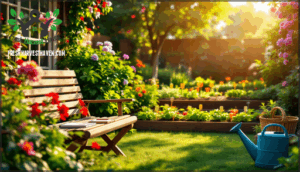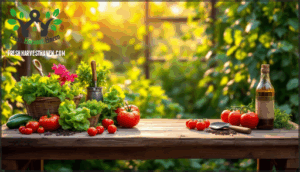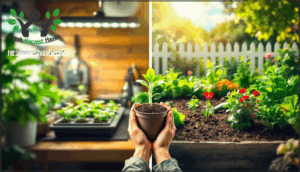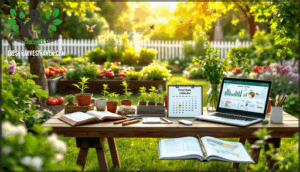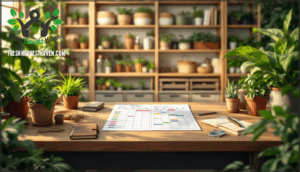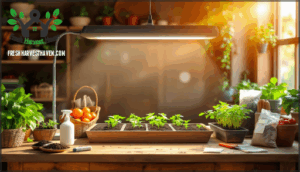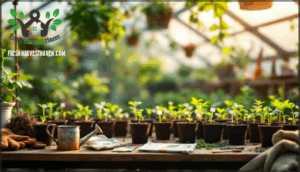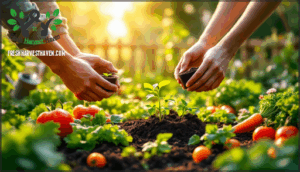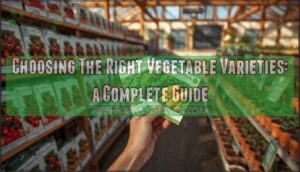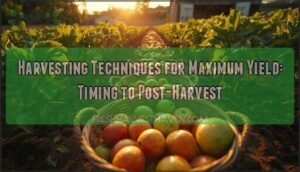This site is supported by our readers. We may earn a commission, at no cost to you, if you purchase through links.
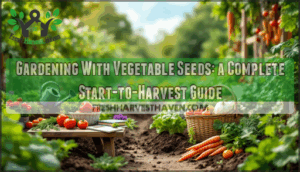
Starting from seed flips that script entirely. You’ll spend pennies per plant instead of dollars, gain access to hundreds of heirloom varieties that never see a garden center shelf, and control exactly what touches your food from day one.
The learning curve exists, but it’s shorter than you think. Once you understand frost dates, seed depth, and a few transplanting basics, you’ll wonder why you ever paid $4 for a single tomato plant when a packet of seeds costs the same and yields thirty.
Table Of Contents
- Key Takeaways
- Benefits of Growing Vegetables From Seed
- Planning Your Vegetable Seed Garden
- Choosing Vegetable Seeds to Grow
- Starting Vegetable Seeds Indoors and Outdoors
- Planting and Caring for Seedlings
- Transplanting and Maintaining Your Vegetable Garden
- Frequently Asked Questions (FAQs)
- How do you start a vegetable garden using seeds?
- What vegetables should you start from seed?
- Can you plant vegetable seeds in a garden bed?
- What to plant in a vegetable garden?
- Is growing vegetables from seed a good idea?
- When should you plant vegetable seeds in a garden?
- How do I fix seeds that wont germinate?
- What causes seedlings to suddenly die or wilt?
- Can I save seeds from store-bought vegetables?
- How do I prevent pests from eating seedlings?
- Conclusion
Key Takeaways
- Starting vegetables from seed costs pennies per plant compared to dollars for nursery transplants, while unlocking access to hundreds of heirloom varieties unavailable at commercial garden centers.
- Success hinges on understanding your USDA hardiness zone and last frost date—these determine which crops will survive and when to safely start seeds indoors or transplant seedlings outside.
- Indoor seed starting gives you climate control and an extended growing season, while direct outdoor sowing eliminates transplant shock for crops that don’t tolerate root disturbance.
- Saving seeds from open-pollinated varieties creates crops adapted to your specific microclimate over time, reducing costs while building genuine food independence and preserving genetic diversity.
Benefits of Growing Vegetables From Seed
Starting vegetables from seed isn’t just about growing food—it’s about taking control of what ends up on your plate and how it gets there. You’ll save money, discover varieties you’d never find at a garden center, and gain skills that make you more self-reliant season after season.
Here’s what makes seed starting worth the effort.
Cost Savings and Value
Growing your own vegetables from seed can slash your grocery bill by as much as 90% compared to buying transplants—and that’s just the beginning of what you’ll save. A single seed packet costs roughly $3 but yields dozens of plants, making cost efficiency unbeatable for beginners focused on budget planning.
With proper gardening tips for growing conditions and smart crop yield strategies, you’ll boost seed savings while slashing garden expenses. This sustainable gardening practice puts you in complete control of your food supply.
Access to Unique and Heirloom Varieties
Beyond savings, starting from seed unlocks hundreds of heirloom varieties you’ll never find at nurseries—rare varieties bred for flavor, not shipping. Seed catalogs list over 50 distinct tomato types and 30 bean plant varieties, preserving genetic diversity lost to commercial hybrids. Seed starting connects you to seed preservation traditions spanning centuries, while seed exchange programs distribute 500,000+ packets annually. Vegetable gardening becomes an act of rebellion: you’re reclaiming food sovereignty one heirloom seed at a time. By exploring heirloom vegetable options, gardeners can discover unique flavors and textures.
- Flavor trumps uniformity: Heirloom tomatoes display 20 color variations and consistently outscore hybrids in taste tests
- Save seeds, grow freedom: Open-pollinated varieties let you harvest and replant indefinitely
- Regional adaptation wins: Certain heirloom peppers yield 30% better than hybrids in local trials
Freshness and Quality Control
When you plant a seed and watch it grow, you’re the quality control manager. You decide exactly which pesticides touch your food (or don’t), when to harvest for peak ripeness, and whether to prioritize sweetness over shelf life.
Store-bought produce sits in trucks for days; yours goes from soil to table in minutes, preserving nutrients that degrade within 24 hours of commercial harvesting.
Soil testing and crop rotation guarantee optimal soil health, while precise harvest timing lets you taste vegetables at their absolute flavor peak—a freshness no supermarket chain can replicate.
Learning and Satisfaction
There’s something borderline addictive about troubleshooting a wilting seedling at 6 AM, fixing the problem, and watching that same plant bounce back by noon—you’re not just growing food, you’re building genuine horticultural competence.
Fixing a wilting seedling at dawn and watching it recover by noon builds genuine horticultural competence, not just vegetables
Each season sharpens your skill building through hands-on plant care, and the gardening experience connects you to a gardener community that trades practical gardening tips and techniques.
Vegetable gardening transforms beginners into confident growers who understand what plants actually need, not just what the label says.
Sustainability and Seed Saving
By saving seeds from your strongest plants, you’re not just cutting costs—you’re adapting varieties to your specific soil, climate, and growing conditions in a way no catalog ever could. This seed banking practice fosters biodiversity preservation and strengthens sustainable gardening practices through natural selection.
Join seed swaps and exchange networks to diversify your collection while practicing eco-friendly methods that honor soil conservation and genuine food security.
Planning Your Vegetable Seed Garden
Before you plant a single seed, you need to think through where and how you’ll grow your vegetables. The right setup makes everything easier—from watering to harvesting.
Here’s what to keep in mind when designing your garden space.
Choosing The Right Location
Your vegetable garden’s success hinges on one fundamental truth: plants can’t pick up and move if you choose the wrong spot, so you need to get the location right from day one.
Start with the basics—most vegetables demand six to eight sunlight hours daily. Check your soil quality through simple soil testing to understand what you’re working with. Your plant hardiness zone dictates which crops will thrive, so don’t fight your climate.
Good drainage matters as much as sun exposure.
Selecting Plot Size and Layout
Start small if you’re new to this—a 4×4 foot plot yields more food than you’d think, and it won’t leave you drowning in weeds come July.
Map your garden layout with these space optimization strategies:
- Plot planning starts with access—leave 18-24 inches between beds for comfortable maintenance
- Garden design flows north to south so tall plants won’t shade shorter crops
- Soil mapping reveals which areas drain faster or retain moisture longer
- Bed design works best when you can reach the center without stepping on soil
- Planting density matters—intensive spacing maximizes yield without crowding roots
Your vegetable gardening success depends on thoughtful garden planning, not square footage.
Raised Beds Vs. In-Ground Gardens
Choosing between raised beds and in-ground gardens isn’t just about aesthetics—it’s about control versus simplicity, and both approaches can deliver impressive harvests. Raised beds give you complete authority over soil depth and drainage systems, while in-ground gardens work with what you’ve got. Your garden layout and space efficiency goals will determine which approach fits your vegetable gardening vision.
| Factor | Raised Garden Bed | In-Ground Garden |
|---|---|---|
| Soil Control | Complete control over soil science and amendments | Works with existing native soil composition |
| Drainage | Enhanced drainage systems prevent waterlogging | Drainage depends on natural soil structure |
| Setup Cost | Higher initial investment in bed materials | Minimal cost—just soil amendments needed |
| Garden Planning | Easier access, less bending, defined bed materials | Requires more space but unlimited expansion |
Raised beds excel in poor-soil areas, offering enhanced control and drainage, while in-ground plots provide budget-friendly simplicity, working with the existing soil composition and requiring minimal setup costs.
Understanding Your Growing Zone
Think of the USDA Hardiness Zone map as your vegetable garden’s instruction manual—it tells you which plants can survive your coldest winter nights. These climate zones divide regions by average minimum temperatures, helping you match seeds to your local hardiness levels.
The 2023 update shows roughly half the U.S. shifted into warmer zones, reflecting climate trends that extend growing seasons and alter soil temperatures for regional gardening success.
Understanding the impact of climate change effects is essential for adapting gardening practices to the new hardiness zones.
Choosing Vegetable Seeds to Grow
Picking the right seeds can feel like holding the keys to your own food supply—because you are. You’ll need to think about what thrives in your climate, what you actually want to eat, and where to find quality seeds you can trust.
Let’s break down how to choose varieties that’ll set you up for a harvest worth celebrating.
Selecting Easy-to-Grow Vegetables
Radishes can be ready in as little as 21 days—that’s faster than most mail deliveries. For your first vegetable garden, prioritize crops known for dependable germination and quick results. Lettuce, spinach, and radishes top the list, with germination rates near 98% and harvest windows under 45 days.
Bush beans, turnips, and cherry tomatoes offer reliability without demanding expert skills, making them ideal vegetable choices for building confidence while you master soil preparation and garden planning fundamentals.
Using Seed Catalogs and Reliable Sources
Once you’ve narrowed down your short list of easy growers, reputable seed catalogs become your gateway to varieties that actually perform—not just look pretty on a packet. Look for companies with detailed growing information, regional adaptation notes, and transparent seed quality standards.
Gardener reviews offer real-world feedback on germination rates and disease resistance—your best insurance against disappointing harvests. Prioritize sources specializing in vegetable gardening over generic retailers for proven planting success.
Deciding What and How Much to Plant
After you’ve locked in your seed sources, the real challenge isn’t finding what to grow—it’s resisting the urge to plant everything at once. Start with crop selection based on what you actually eat, then calculate seed quantity using your available garden space.
A diverse mix prevents overwhelming harvests of one vegetable while guaranteeing steady yield estimation throughout the season—essential vegetable gardening tips for beginners mastering plant selection and care.
Hybrid Vs. Open-Pollinated Vs. Organic Seeds
Now that you’ve narrowed your list, understanding seed types will sharpen your plant selection and care strategy. Hybrids deliver 90-95% germination rates and uniform performance—hybrid benefits that justify the extra dollar or two per packet.
Open-pollinated seeds cost less, offer better seed longevity (5-7 years versus 3-4), and let you save seeds year after year.
Organic costs run 20-40% higher but align with organic gardening principles.
Your choice hinges on whether you prioritize seed viability and predictability or long-term sustainability in vegetable gardening.
Starting Vegetable Seeds Indoors and Outdoors
Once you’ve chosen what to grow, you’ll need to decide whether to start your seeds indoors or sow them directly into the garden. Each method has its own advantages depending on your climate, the vegetables you’re planting, and how much time you want to invest.
Here’s what you need to know about both approaches and how to plan your seed starting timeline.
Indoor Vs. Outdoor Sowing Pros and Cons
When you’re deciding between starting seeds indoors or sowing them straight into the garden, you’re fundamentally choosing between control and convenience—and both paths can lead you to a thriving harvest.
Indoor gardening gives you:
- Climate control over soil temperature and light exposure for ideal seed germination
- Extended growing season by starting heat-loving vegetables before outdoor conditions allow
- Protection from pests and unpredictable weather during vulnerable early growth
Direct sowing outdoors means less transplant shock and works beautifully for crops that don’t tolerate root disturbance. Your choice depends on your vegetable gardening goals and regional climate.
When to Start Seeds Based on Frost Dates
Your last frost date isn’t just a calendar entry—it’s the single most important number that dictates when you can safely move seeds and seedlings from the controlled environment indoors to the unpredictable world outside. Count backward from that date using seed packet instructions—most vegetables need 4-8 weeks indoors before transplanting.
Climate zones and local weather forecasting help you nail your timing, turning gardening basics into reliable harvests for beginners ready to break free from guesswork.
Organizing a Seed Starting Schedule
A seed starting schedule transforms scattered impulses into an orchestrated timeline that keeps your seedlings on track and your garden thriving without the chaos of last-minute planting decisions. Your planting calendar becomes your personal seed inventory roadmap:
- Mark frost dates and count backward for each crop
- Block out planting weeks for cool-season versus warm-season vegetables
- Plan crop rotation to avoid soil depletion
- Schedule soil preparation tasks before sowing
- Track actual planting dates to adjust next year’s garden planning
This simple system puts you firmly in control.
Essential Equipment and Supplies
Turning seeds into seedlings doesn’t require a greenhouse or fancy gadgets—just a few basic tools that give your plants the head start they deserve. You’ll need seed trays with drainage, quality seed-starting soil, and consistent moisture through simple irrigation systems. Here’s what matters most:
| Equipment | Purpose | Why You Need It |
|---|---|---|
| Seed trays or cell packs | Hold soil and seeds | Prevents root disturbance during transplant |
| Sterile seed-starting mix | Provides growing medium | Reduces disease risk and guarantees drainage |
| LED grow lights or sunny window | Delivers 14-16 hours light | Prevents leggy, weak seedlings |
Basic gardening tools like labels, a spray bottle, and soil testers complete your setup—no greenhouse materials required.
Planting and Caring for Seedlings
Getting seeds to sprout is one thing—keeping those fragile seedlings alive and thriving is where the real work begins. You’ll need to nail the basics: planting depth, spacing, light, and water.
Here’s what separates successful seedlings from the ones that never make it to your garden.
How Deep to Plant Vegetable Seeds
Most gardening failures don’t happen because you forgot to water—they happen because you buried your seeds too deep or left them sitting on the surface like forgotten confetti. The general rule: plant seeds two to three times as deep as their width.
Tiny seeds like lettuce need light to germinate, so press them gently into warm soil. Large seeds like beans can tolerate an inch or more.
Check your seed packet for specific sowing techniques—those planting tools and depth guidelines aren’t just suggestions.
Proper Seed Spacing and Thinning
Crowded seedlings fight for nutrients like shoppers at a clearance sale—and nobody wins. Follow row spacing guidelines on your seed packet—usually one to three inches for most vegetables.
Once seed germination happens and true leaves appear, thin seedlings ruthlessly. Snip extras at soil level rather than pulling them out.
Proper plant density prevents disease, improves airflow, and gives you stronger harvests. Spacing isn’t optional—it’s survival.
Watering and Light Requirements
Seedlings need two things to survive: consistent moisture and enough light—mess up either one, and you’ll watch them wilt or stretch into weak, spindly disasters.
Watering tips:
- Check soil moisture daily—stick your finger an inch deep; if it’s dry, water immediately
- Use bottom watering or gentle irrigation methods to avoid disturbing delicate roots and guarantee proper soil drainage
- Water scheduling matters: morning hydration facilitates photosynthesis needs throughout the day
Direct sunlight (6-8 hours minimum) fuels strong growth. Without adequate light intensity, seedlings can’t photosynthesize properly—they’ll lean toward windows desperately searching for what they’re missing.
Using LED Grow Lights for Seedlings
If you don’t have a sunny south-facing window or enough natural light, LED grow lights can bridge the gap and give your seedlings exactly what they need to thrive. Position your grow light 2-3 inches above seedlings and keep it on for 16 hours daily—this mimics ideal outdoor conditions.
LED benefits include energy efficiency and minimal heat output, preventing scorched leaves while supporting plant nutrition needs for growing vegetables indoors.
Common Mistakes and Troubleshooting
Even with proper lighting, seed depth errors can derail your efforts—planting lettuce or dill too deep blocks the light they need to sprout. Temperature control matters too; peppers won’t germinate below 70°F, while overwatering issues invite damping-off and root rot. Watch for these red flags:
- Germination failure from old seeds or incorrect soil quality matters
- Leggy seedlings signal inadequate light or early sowing timing mistakes
- Fungus gnats thrive in consistently wet conditions—adjust watering immediately
Apply these gardening tips for planting and transplanting, practice pest management, and follow gardening safety tips to troubleshoot problems before they spread through your vegetable gardening setup.
Transplanting and Maintaining Your Vegetable Garden
Your seedlings are almost ready to step outside and become full-fledged garden plants. But moving them from indoor comfort to the outdoor world takes a bit of strategy—rush it, and you’ll lose them to shock or stress.
Here’s how to shift your plants safely and keep them thriving all season long.
Hardening Off Seedlings for Outdoors
Before your seedlings can brave the great outdoors, they’ll need a gentle wake-up call to the realities of wind, sun, and temperature swings. This outdoor shift, called seedling acclimation, takes about 7-10 days.
Start by placing your vegetable gardening trays in a sheltered, shaded spot for just an hour or two. Gradually increase their exposure each day while managing shade and weather protection—this critical gardening technique prevents shock and strengthens your seed-grown plants for successful transplanting.
Transplanting Seedlings Safely
Once your seedlings have toughened up outdoors, the real test comes when you lift them from their cozy containers and settle them into garden soil—timing and technique here can make or break your harvest. Transplant on overcast days or in the evening to minimize seedling shock.
Water your containers thoroughly an hour beforehand—root protection starts with moist soil that clings together. Dig holes slightly larger than root balls, position plants at the same depth they grew indoors, and firm soil gently around stems for proper soil acclimation and garden placement.
Ongoing Care and Maintenance
Your seedlings won’t raise themselves—consistent watering, vigilant pest monitoring, and timely feeding separate thriving plants from struggling ones. Check soil moisture daily—water management means deep soaking when the top inch dries out. Apply balanced fertilizer every two weeks for vigorous plant care. Scout for pests weekly and remove damaged leaves using proper pruning techniques.
Mulch around plants to maintain soil health and suppress weeds—these gardening maintenance habits guarantee your harvest reaches its full potential.
Sustainable Practices and Seed Saving
By embracing eco-friendly gardening through composting and sustainable harvesting, you’re building climate resilience into your garden’s DNA. Seed banking and seed swaps preserve biodiversity conservation—saving open-pollinated varieties year after year creates crops adapted to your microclimate.
These organic gardening methods cut packaging waste while strengthening food security. Follow these gardening tips and advice: let your best plants fully mature, collect dry seeds, and store them properly for sustainable gardening success.
Frequently Asked Questions (FAQs)
How do you start a vegetable garden using seeds?
Well begun is half done," they say—and it starts with choosing the right seeds for your zone, preparing nutrient-rich soil, and mapping your garden layout.
Pick easy vegetables, gather basic gardening tools, and plan your planting schedule around frost dates for success.
What vegetables should you start from seed?
Start tomatoes, peppers, and eggplants indoors—they need a long season. Cucumbers, squash, and beans prefer direct sowing outdoors. Lettuce and radishes work either way.
Your garden planning and seed selection should match your zone’s frost dates for successful vegetable gardening.
Can you plant vegetable seeds in a garden bed?
Yes, you can plant vegetable seeds directly into a garden bed. Proper soil preparation, thoughtful seed selection, and strategic garden layout guarantee success.
Use crop rotation and bed maintenance practices to support healthy growth.
Attend seed swaps for variety access.
What to plant in a vegetable garden?
Choose vegetables based on your growing zone, available space, and what you love to eat. Crop selection matters—beginners should focus on reliable varieties like tomatoes, lettuce, peppers, and beans while considering proper garden layout and soil preparation for planting success.
Is growing vegetables from seed a good idea?
Growing from seed gives you control over seed quality and crop diversity while cutting costs.
You’ll master essential gardening techniques—from soil preparation through planting to harvest timing—building real expertise that transforms your vegetable gardening success.
When should you plant vegetable seeds in a garden?
Timing your planting with frost dates and soil temperature prevents seedlings from dying in late cold snaps. Cool-season crops like lettuce tolerate spring frost, while warm-season vegetables need soil above 60°F for germination success. Check your climate zone’s gardening calendar.
How do I fix seeds that wont germinate?
Poor seed viability, incorrect soil temperature, or improper moisture levels can prevent germination. Check seed storage conditions and test viability first.
Then adjust soil amendments, maintain consistent warmth, and maintain even moisture—these gardening tips for planting and transplanting will rescue your vegetable gardening efforts.
What causes seedlings to suddenly die or wilt?
Damping off hits like a thief in the night—your seedlings collapse overnight. Water stress, poor soil quality, root damage, and pests infestation are common culprits. Plant diseases and nutrient deficiency also trigger wilting.
These garden problems plague vegetable gardening, but proper gardening tips help you protect your seedlings.
Can I save seeds from store-bought vegetables?
It depends. Hybrids often produce seeds that won’t grow true to the parent plant, limiting seed viability and genetic diversity.
Open-pollinated store-bought vegetables work better for seed saving, but many are hybrids bred for commercial use, not home vegetable gardening.
How do I prevent pests from eating seedlings?
What’s guarding your tender greens worth? Protect seedlings with physical barriers like row covers or cloches, apply organic repellents such as neem oil, and use natural deterrents like crushed eggshells around plants to keep garden pests at bay.
Conclusion
Think of gardening with vegetable seeds as learning to ride a bike—wobbly at first, but once you’ve got it, you’re off and flying. You’ve now got the blueprint: timing, technique, and troubleshooting. The nursery markup? History. Those rare heirloom tomatoes? Already on your list.
Start small, plant what excites you, and let each season sharpen your instincts. Your garden won’t just grow vegetables—it’ll grow your confidence, independence, and a deeper connection to what ends up on your plate.
- https://store.almanac.com/pages/most-popular-club?utm_source=edit&utm_medium=banner&utm_campaign=gardening_club
- https://garden.org/nga/zipzone/
- https://www.johnnyseeds.com/tools-supplies/seed-starting-supplies/trays-domes-and-flats/leakproof-trays-100-count-9515.html?cgid=trays-domes-and-flats
- https://en.wikipedia.org/wiki/Hardiness_zone
- https://www.pbs.org/newshour/science/climate-change-is-shifting-plant-growth-zones-heres-what-to-know-for-your-garden-this-year

